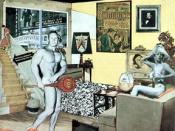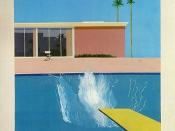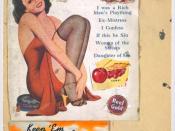Pop Art; an Introduction to the Era;
In this investigation I plan to conduct an investigation into the similarities and differences between American and British pop art. Pop art started in the late 1950's in England, and grew in the United States in the early 1960's. English art critic Lawrence Holloway first used the term Pop in an edition of architectural digest; he was describing all post war work centered on consumerism and materialism, and that rejected the psychological allusions of abstract expressionism. The term referred to the interest of a number of artists in the images of mass media, advertising, comics and consumer products. The 1950s were a period of optimism in Britain following the end of wartime rationing, and a consumer boom took place. An attempt to bring art back into American daily life, it rejected abstract painting because of its sophisticated and elite nature. Pop Art shattered the divide between the commercial arts and the fine arts.
The Pop Art movement originated in England in the 1950s and traveled overseas to the United States during the 1960s. Richard Hamilton and Eduardo Paolozzi pioneered the movement in London in the 1950s. In the 1960s, Peter Blake, Patrick Caulfield, David Hockney, Allen Jones, and Peter Phillips carried on the movement. In the early sixties, Pop art found its way to the United States, seen in the work of Jim Dine, Roy Lichtenstein, and Robert Rauschenberg. It developed in the United States as a response to the wealth of the post World War II era and the growing materialism and consumerism in society. The most recognized Pop Artist, Andy Warhol, used a photo-realistic, mass production printmaking technique called serigraphy to produce his commentaries on media, fame, and advertising.
Pop Art made observations on contemporary society and culture, particularly consumerism, by...


